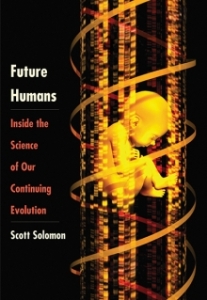Future Humans by Scott Solomon. Book review. Source book for science-fiction writers

Future Humans is a voyage through human evolution and the science of evolution, but from a perspective you might not have previously considered.
We are no longer in a world where populations are separated by vast distances isolating gene pools which evolve with a slow and steady pace. With modern transport these distances are rapidly closing and we are no longer living in small communities. That much is obvious to anyone, but what most people don’t give much thought to are the microscopic companions who have always been with us, hanging in there for whatever ride we take them on.
These bugs are capable of exerting some very interesting physiological effects on their hosts. When you begin to realise that humans are not the only ones whose lives rely on these microbes, then this opens up a much larger debate on the evolutionary process and where we stand in it. For example, removing bacteria from wasps’ guts makes it possible for different species to interbreed. Reintroduce the microbes and once again the breeding process is only possible between same species. This really makes you stop and think about our relationship with the humble gut bacteria.
The science in this book is not just limited to the Earth, because at some point we may well be moving off it to live elsewhere. So what happens then? How do you live on a planet like Mars given the radiation exposure humans will have there, and the effect of the microgravity on the human body? It is supposedly a pristine planet in the sense that the only microbes brought there would be by humans and the effects of the gravity would radically reduce the bone mass of those living there. Humans living on Mars would not easily be able to return to Earth given the re-entry conditions are eight times the gravity experienced on Earth. How do we evolve to deal with these problems?
This is certainly all food for thought, not just for scientists, but also writers of science-fiction.
However, this book is also so much more than a fascinating trip into the subtleties of evolution, because it links all types of scientific research into the human element of the people doing this type of cutting edge thinking and experimenting.
Scott Solomon takes you on his visits to colleagues, so that you, the reader, feel as if you are having coffee and a chat with some very interesting individuals, because scientists are people, each with their own unique characteristics and quirks.
Many people tend to have the stereotypical picture of scientists as people in crisp white coats in pristine laboratories and psychologically far removed from the intended object of their experiments. Solomon fractures that vision by introducing colourful characters with backstories which explain their unstinting passion for their work. These are very much people in touch with the hard reality, which triggered the need for their tireless efforts, at times going to great lengths on the ground to get their samples.
This is an excellent book for those who are interested in a general science read and want something that takes them on a journey and makes them think, or fiction writers who need to consider the science of evolution.
Future Humans is a book that overlaps into the territory of Welcome to the Microbiome by Rob Desalle, Susan L. Perkins and Patricia J. Wynne, also by Yale University Press. Both books make good companions for each other.
Future Humans was courtesy of Yale University Press via NetGalley

Thank you for this! Think I might have to hunt down a copy!